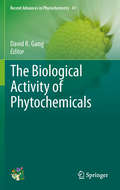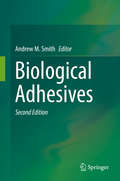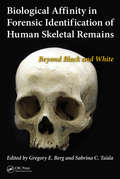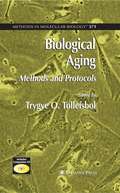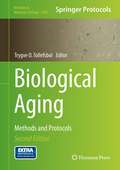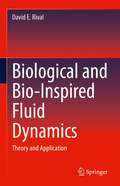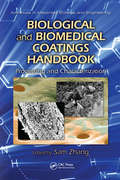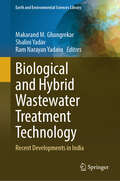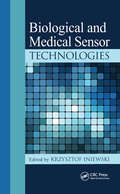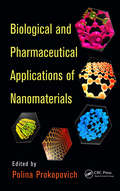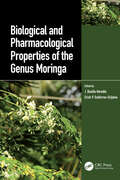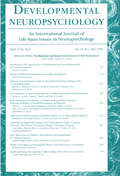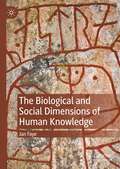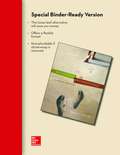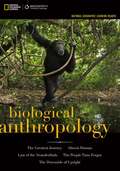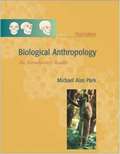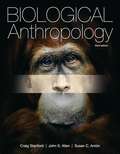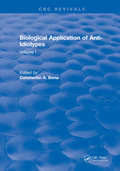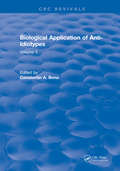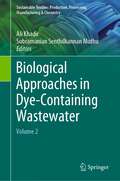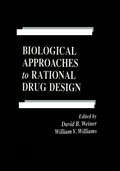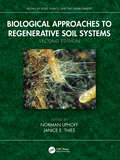- Table View
- List View
The Biological Activity of Phytochemicals
by David R GangThis is the first volume to be published under a new series agreement for Recent Advances in Phytochemistry, co-published with the Phytochemical Society of North America.
Biological Adhesives
by Andrew M. SmithMany creatures use adhesive polymers and structures to attach to inert substrates, to each other, or to other organisms. This is the first major review that brings together research on many of the well-known biological adhesives dealing with bacteria, fungi, algae, and marine and terrestrial animals. As we learn more about their molecular and mechanical properties we begin to understand why they adhere so well and with this comes broad applications in areas such as medicine, dentistry, and biotechnology.
Biological Affinity in Forensic Identification of Human Skeletal Remains: Beyond Black and White
by Gregory E. Berg Sabrina C. Ta’alaAncestry determination in the identification of unknown remains can be a challenge for forensic scientists and anthropologists, especially when the remains available for testing are limited. There are various techniques for the assessment of ancestry, ranging from traditional to new microbiological and computer-assisted methods. Biological Affinity
Biological Aging: Methods and Protocols (Methods in Molecular Biology #371)
by Trygve O. TollefsbolThis book investigates the various processes that are affected by the age of an organism. Several new tools for the analysis of biological aging have been introduced recently, and this volume provides methods and protocols for these new techniques in addition to its coverage of established procedures. Researchers seeking new technology and techniques will find this volume of tremendous benefit as they move towards new directions.
Biological Aging: Methods and Protocols (Methods in Molecular Biology #1048)
by Trygve O. TollefsbolThe second edition of Biological Aging: Methods and Protocols expands upon the previous edition with current, detailed, useful and promising methods currently available to study aging. With new chapters on protocols that detail aging cell culture as well as many more contemporary approaches such as nuclear transfer, microarray and proteomics technologies. Written in the highly successful Methods in Molecular Biology series format, chapters include introductions to their respective topics, lists of the necessary materials and reagents, step-by-step, readily reproducible laboratory protocols, and key tips on troubleshooting and avoiding known pitfalls. Authoritative and practical, Biological Aging: Methods and Protocols, Second Edition details the most recent breakthroughs in technology that have served to advance the study of aging.
Biological and Bio-Inspired Fluid Dynamics: Theory and Application
by David E. RivalThis text provides the reader with tools necessary to study biological and bio-inspired flows, all the while developing an appreciation for their evolutionary and engineering constraints. It is suitable for students already exposed to introductory concepts in fluid mechanics and applied mechanics as a whole, but who would not need an advanced training in fluid mechanics per se. Currently no textbook exists that can take students from an introductory position in fluid mechanics to these contemporary topics of interest. The book is ideal for upper-level undergraduates and graduate students studying a range of engineering domains as well as biology, or even medicine.
Biological and Biomedical Coatings Handbook: Processing and Characterization
by Sam ZhangWritten in a versatile, contemporary style that will benefit both novice and expert alike, Biological and Biomedical Coatings Handbook, Two-Volume Set covers the state of the art in the development and implementation of advanced thin films and coatings in the biological field. Consisting of two volumes-Processing and Characterization and Applicatio
Biological and Biomedical Coatings Handbook: Applications (Advances in Materials Science and Engineering)
by Sam ZhangWritten in a versatile, contemporary style that will benefit both novice and expert alike, Biological and Biomedical Coatings Handbook, Two-Volume Set covers the state of the art in the development and implementation of advanced thin films and coatings in the biological field. Consisting of two volumes-Processing and Characterization and Applicatio
Biological and Hybrid Wastewater Treatment Technology: Recent Developments in India (Earth and Environmental Sciences Library)
by Shalini Yadav Ram Narayan Yadava Makarand M. GhangrekarThis book provides technical information on different biological and hybrid wastewater treatment systems for the treatment of wastewater and reuse, and tracks their progress towards practical and field-scale applications including strategies to be adopted for minimizing the losses and maximizing the benefits, as well as protecting the environment through the application of advanced biological and hybrid wastewater treatment Technology. In addition, it discusses the crucial parts that science, technology, and innovation play in the formulation, implementation, and administration of wastewater treatment policy. It highlights the challenges that must be overcome to adopt biological and hybrid wastewater treatment infrastructure regulations successfully and provides some answers. Also, it investigates how the biological and hybrid wastewater treatment technology may be used in a wide variety of field's sets apart from other on-the-shelf publications on the market. Also, it delves into the core concepts of Biological and Hybrid Wastewater Treatment Systems. It explores how these concepts can be modified to fit a variety of contexts and uses. Applications such as managing facilities, dealing with pandemics, urban wastewater treatment and reuse, farming, and other applications are included in this book. As a consequence, this book's content is engaging, and it will pique the interest of a diverse audience of readers who come from a wide variety of different professional backgrounds. Therefore, the book is written by local experts in the topic who dealing with the treatment of wastewater treatment technologies for a long time in India. This book will be helpful to researchers, entrepreneurs, professionals, planners, policymakers, environmental engineers, and others interested in biological and hybrid wastewater treatment system management strategies through the application of breakthroughs in biological and hybrid wastewater treatment technologies.
Biological and Medical Sensor Technologies (Devices, Circuits, and Systems)
by Krzysztof IniewskiBiological and Medical Sensor Technologies presents contributions from top experts who explore the development and implementation of sensors for various applications used in medicine and biology. Edited by a pioneer in the area of advanced semiconductor materials, the book is divided into two sections. The first part covers sensors for biological applications. Topics include: Advanced sensing and communication in the biological world DNA-derivative architectures for long-wavelength bio-sensing Label-free silicon photonics Quartz crystal microbalance-based biosensors Lab-on-chip technologies for cell-sensing applications Enzyme biosensors Future directions for breath sensors Solid-state gas sensors for clinical diagnosis The second part of the book deals with sensors for medical applications. This section addresses: Bio-sensing and human behavior measurements Sweat rate wearable sensors Various aspects of medical imaging The future of medical imaging Spatial and spectral resolution aspects of semiconductor detectors in medical imaging CMOS SSPM detectors CdTe detectors and their applications to gamma-ray imaging Positron emission tomography (PET) Composed of contributions from some of the world’s foremost experts in their respective fields, this book covers a wide range of subjects. It explores everything from sensors and communication systems found in nature to the latest advances in manmade sensors. The end result is a useful collection of stimulating insights into the many exciting applications of sensor technologies in everyday life.
Biological and Pharmaceutical Applications of Nanomaterials
by Polina ProkopovichBiological and Pharmaceutical Applications of Nanomaterials presents the findings of cutting-edge research activities in the field of nanomaterials, with a particular emphasis on biological and pharmaceutical applications. Divided into four sections-nanomaterials for drug delivery, antimicrobial nanomaterials, nanomaterials in biosensors, and safet
Biological and Pharmacological Properties of the Genus Moringa
by J. Basilio HerediaThere is an increasing interest in plants of the Moringa genus used as a source of phytochemicals with biopharmaceutical potential, as a functional ingredient in many products and as an additive in poultry feeding stocks. Biological and Pharmacological Properties of the Genus Moringa is the first publication to comprehensively assess the latest research on Moringa studies. This book reviews recent studies covering the botanical, agronomical, genomic, biotechnological, and ethnopharmacological aspects. It presents specialized work in a user-friendly way that will appeal to undergraduates, graduates and researchers primarily in ethnopharmacology, functional foods and with a linkage to veterinary treatments. Key Features: Describes the ethnopharmacological and ethnobotanical use of plants from all Moringa species Presents recent information that will be helpful for the future development of biopharmaceuticals Reviews the phytochemical content from all Moringa species Assesses the potential of all Moringa species as a functional ingredient
The Biological and Social Determinants of Child Development: A Special Double Issue of developmental Neuropsychology
by Steven M. LeharThe Biological and Social Determinants of Child Development stimulates cross-disciplinary communication and research collaboration in the field of child development. While the papers in this issue seem diverse in terms of topic and discipline, there are a number of common themes: *critical period for brain development and the importance of specific environmental input during this period; *importance of early brain development and enriched environments is supported in articles describing findings from human studies; *potential for brain plasticity following specialized retraining is found in a compelling paper demonstrating different profiles of brain activation for normal readers vs. those who have dyslexia and younger children at high risk for development of reading disabilities; and *critical period, brain plasticity, and parallel changes in developing behavior and brain structure and functioning. As a number of papers in this issue describe potential interventions, one is relevant because it describes the numerous factors that make results of such studies have the potential to generalize to larger populations. Putting the described papers in a broad perspective, the last article argues that we cannot understand the health status of a society without understanding the health-determining influences across the life course.
The Biological and Social Dimensions of Human Knowledge
by Jan FayeTraditionally, philosophers have argued that epistemology is a normative discipline and therefore occupied with an a priori analysis of the necessary and sufficient conditions that a belief must fulfill to be acceptable as knowledge. But such an approach makes sense only if human knowledge has some normative features, which conceptual analysis is able to disclose. As it turns out, philosophers have not been able to find such features unless they are very selective in their choice of examples of knowledge. Much of what we intuitively think functions as knowledge, both in human and non-human animals, does not share these normative features.The purpose of this book is to demonstrate that natural selection has adapted human sense impressions to deliver reliable information without meeting the traditional commitments for having knowledge. In connection with memory, sensory and bodily information provides an animal with experiential knowledge. Experiential knowledge helps an animal to navigate its environment. Moreover, experiential knowledge has different functions depending on whether the deliverance of information stems from the organism’s external or internal senses.
Biological Anthropology: Concepts and Connections
by Agustín FuentesBiological Anthropology: Concepts and Connections shows the relevance of anthropological concepts to today's students and encourages critical thinking. Throughout the text and especially in its many “Connections” features, Agustin Fuentes links anthropological concepts and questions to students’ lives. One of the top scholars in the field of biological anthropology, Agustin Fuentes’ current research looks at the big questions of why humans do what they do and feel the way they feel. He is committed to an integrated, holistic anthropological approach. Fuentes wrote this text to help answer the “so what” questions and make anthropological knowledge relevant to everyday life.
Biological Anthropology
by National Geographic Learning StaffBring your learning to life with compelling images, media and text from National Geographic. National Geographic Reader: Biological Anthropology will help you develop a clearer understanding of the world around you through engaging content.
Biological Anthropology: An Introductory Reader 3rd ed.
by Michael Alan ParkThis supplementary reader demonstrates the significant contributions made by biological anthropology.
Biological Anthropology (3rd Edition)
by Craig Stanford John S. Allen Susan C. AntonDiscover the Best of Biological Anthropology: From its Earliest Foundations to its Most Current Innovations Biological Anthropology, 3/e is written to appeal to a wide range of students. It continues to build upon the strength and success of its first and second editions by integrating the foundations of the field with the most current innovations happening today. Over the past 40 years, biological anthropology has rapidly evolved from the study of physical anthropology into biological anthropology. Biological anthropology is now an integrative combination of information from the fossil record and the human skeleton, genetics of individuals and of populations, our primate relatives, human adaptation, and human behavior. The third edition of Biological Anthropology combines the most up-to-date, comprehensive coverage of the foundations of the field with modern innovations and discoveries. Teaching and Learning Experience Personalize Learning - MyAnthroLab delivers proven results in helping students succeed, provides engaging experiences that personalize learning, and comes from a trusted partner with educational expertise and a deep commitment to helping students and instructors achieve their goals. Improve Critical Thinking - Visual summaries, critical thinking questions, Insights and Advances boxes and author suggested readings found within each chapter encourage students to examine assumptions, discern hidden values, evaluate evidence, assess conclusions, and more!
Biological Application of Anti-Idiotypes: Volume I
by Constantin A. BonaThe goal of this book is to present findings which are supportive of the concept that the words of the idiotype dictionary and likewise self-recognition are essential for communication between lymphocyte clones while some unfaithful ( infidel ) copies of the words contained in the idiotype dictionary perhaps play a role in the functional regulation of nonlymphoid cells.
Biological Application of Anti-Idiotypes: Volume II
by Constantin A. BonaThe goal of this book is to present findings which are supportive of the concept that the words of the idiotype dictionary and likewise self-recognition are essential for communication between lymphocyte clones while some unfaithful ( infidel ) copies of the words contained in the idiotype dictionary perhaps play a role in the functional regulation of nonlymphoid cells.
Biological Applications of Nanoparticles
by Biplab Sarkar Avinash SonawaneThis textbook for graduate and postgraduate students provides comprehensive applications of nanoparticles in medicine, agriculture, and environmental sciences. The initial chapter covers basic topics related to types, synthesis, structure, and properties of various nanoparticles. It further discusses the wide range of applications of nanoparticles in medicine, agriculture, and the environment. The book presents nano-electronic biosensors that are used to diagnose and monitor the progression of human diseases. It summarizes the opportunities and challenges of nanotechnology in the agriculture and food sector highlighting the scientific, technical, regulatory, safety, and societal impacts. Additionally, it illustrates the applications of nanotechnology in the field of aquaculture medicine, bioinformatics and food technology. The textbook examines the development and administration of nano-medicines , their applications, advantages, and limitations for the treatment and prophylaxis of a broad range of diseases. Lastly, the textbook explores the recent advances in the field of nanobusiness and nanotechnology issues in intellectual property management( IPR).
Biological Approaches in Dye-Containing Wastewater: Volume 2 (Sustainable Textiles: Production, Processing, Manufacturing & Chemistry)
by Ali Khadir Subramanian Senthilkannan MuthuThis Volume 2 contains essential contributions highlighting the use of biotechnology in dye removal. It begins with an overview of activated sludge process for dye removal along with its limitation is carried out and describes the fundamental concepts of dye-containing textile wastewater treatments, particularly microbial and enzymatic approaches, including the most usual textile wastewater treatments and their trends. It discusses the role microbial biofilms play when employed in the integrated treatment system for effective detoxification, degradation and complete mineralization of pollutants in dye waste effluents. It assesses the most recent advances in the biotransformation of synthetic dyes from wastewater, especially anthraquinone-typed dyes. Phycoremediation as an emerging and efficient technology in dye removal, remediation strategies used by microalgae, and the role of fungi in the dye removal are presented.
Biological Approaches in Dye-Containing Wastewater: Volume 1 (Sustainable Textiles: Production, Processing, Manufacturing & Chemistry)
by Ali Khadir Subramanian Senthilkannan MuthuThe textile industry segment has been continuously expanding and it is reported that the global market was US$1000 billion in 2020. Aside from the fact that textile industry could be profitable and offers several advantages for human life, this industry produces wastewater containing many harmful substances in the form of organic and inorganic moieties. Textile wastewater can lead to serious environmental problems if discharged without treatment. In this first volume of the application of biological mechanisms, processes and units are reviewed in terms of dye degradation and removal. The role of biodegradation, bioaccumulation and biosorption in bio-decolorization are discussed. The book starts with highlighting the fundamentals of aerobic and anaerobic mechanisms having different configurations. The moving bed bioreactor (MBBR), up-flow anaerobic sludge blanket reactors, sequential aerobic/anaerobic batch reactors, membrane bioreactor, etc are also covered in this edition.
Biological Approaches to Rational Drug Design
by David B. Weiner William V. WilliamsThis book exploits an understanding of disease pathogenesis by applying a variety of biological agents to therapy. It provides a broad overview of the current methodologies being applied to biological approaches to rational drug design and in depth analyses of progress in this specific field.
Biological Approaches to Regenerative Soil Systems (Books in Soils, Plants, and the Environment)
by Norman Uphoff Janice E. Thies Andrew S. Ball Febri Doni Olivier Husson Mark Laing David Montgomery Radha Prasanna Jules Pretty Odo Primavesi Stephen WoodAgriculture in the 21st century will need considerable modification to remain both productive and sustainable. Greater production is needed to meet the needs of our still-growing populations and to combat hunger and poverty. Declines in soil health and the pollution of water sources are making many of our production systems less tenable. These adverse trends are exacerbated more and more by the impacts of climate change. There are, fortunately, alternative methods available for agricultural practice that can countervail these constraints. Biological Approaches to Regenerative Soil Systems brings together the work of both researchers and practitioners to map out better approaches to contemporary agriculture that draw upon both old and new knowledge. It presents the science that underlies more biologically driven strategies as well as contemporary innovative experiences in diverse parts of the world. Both accepted research and these varied experiences encourage confidence that these approaches, not relying primarily on the introduction of new varieties and on exogenous inputs, can succeed. This book updates and revises a preceding volume Biological Approaches to Sustainable Soil Systems published by CRC Press in 2006. So much has been learned and done on this subject in the past decade and a half that a second edition was warranted. For instance, the first edition was published, knowledge about plant-soil microbiomes, which are a frequent focus in this book, has mushroomed. Because sustainability is a broad term and an end-state, the editors preferred to assemble expertise regarding regenerative agriculture, which is concerned with the means for achieving sustainability. The concept of regenerative soil systems, entities that are more complex and multifaceted than "soil" alone, also incorporates a concern with having more resilient agricultural systems, ones that are better able to cope with the multiple stresses of climate change that are foreseen for the decades ahead. The book’s chapters representing a wide range of disciplines were contributed by 84 scientists and practitioners from 20 countries. Although they come from persons with in-depth knowledge of their respective fields, the chapters are written to be accessible to readers who are not trained in the specialized subjects. Taken together, the chapters provide students, researchers, practitioners, planners, and policy makers with a comprehensive understanding of both the science and the steps needed to regenerate and sustain soil systems around the world for the long-term benefit of humankind and the environment.
